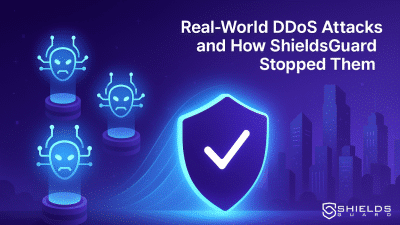Executive Summary: Profiling a Modern Hacktivist Collective
In the increasingly volatile landscape of geopolitical cyber conflict, a new and sophisticated threat actor has emerged, operating under the moniker “Mr. Hamza.” First appearing in October 2024, this group has rapidly distinguished itself from the legion of transient hacktivist collectives through its operational sophistication, strategic acumen, and tactical potency. This ShieldsGuard report provides a comprehensive analysis of the Mr. Hamza group, deconstructing its identity, motivations, technical capabilities, and its pivotal role as a central node in a global network of ideologically aligned cyber actors.
Mr. Hamza is a hacktivist group with a centralized leadership structure that ShieldsGuard Threat Intelligence assesses to be of Moroccan origin. While its operational cells are decentralized, allowing for scalability and resilience, the group’s strategic direction is cohesive and highly reactive to global events. The group’s core strategy positions it as a significant cyber player in geopolitical conflicts spanning from the Middle East to South Asia and Europe.
The group’s primary Tactics, Techniques, and Procedures (TTPs) center on the prolific use of devastating Distributed Denial-of-Service (DDoS) attacks, which it deploys with significant volume and increasing sophistication against high-value targets. The severity of these attacks highlights the critical need for organizations to have advanced protection layers like ShieldsGuard. However, its arsenal is diverse and evolving, supplemented by data leak operations, strategic vulnerability exploitation, and, most alarmingly, the emerging use of ransomware for disruptive rather than purely financial purposes.
What truly sets Mr. Hamza apart is its operational model, which blurs the lines between activism and enterprise. The group has cultivated a self-sustaining ecosystem funded primarily through the development and sale of its own malicious tools, including DDoS stressers and botnets. This “Hacktivism-as-a-Service” (HaaS) model provides financial independence, making Mr. Hamza a far more persistent and formidable threat than traditional volunteer-based collectives.
Furthermore, Mr. Hamza functions as a critical force multiplier within the hacktivist ecosystem, actively collaborating with dozens of other groups. Through these strategic partnerships, Mr. Hamza has demonstrated its ability to project influence and execute synchronized, multi-vector attacks against critical infrastructure and government entities worldwide, cementing its status as a significant and enduring threat to international cybersecurity.
Targeting Doctrine and Geopolitical Nexus
To comprehend the threat posed by Mr. Hamza, one must first dissect the strategic engine that drives its operations. The group’s actions are not random acts of digital vandalism but are carefully planned cyber campaigns targeting specific entities in response to geopolitical events.

The group’s identity is forged in the crucible of the Palestine – israel conflict. Its communications and targeting patterns consistently reflect a foundational operational focus on one of the parties in this conflict. This focus serves as the primary and most powerful driver for recruitment and initial target selection. However, this core focus is strategically elastic. It extends to other conflict zones to justify a much broader range of targets.
The most telling characteristic of Mr. Hamza’s doctrine is its direct and reactive link to real-world geopolitical events. The group functions as a cyber auxiliary, its operational tempo rising and falling in lockstep with international crises. A prime example is its role in the 2025 Iran – israel conflict. Analysis by ShieldsGuard shows that the group’s DDoS attacks against – israeli targets peaked on June 16, 2025, the day immediately following a major – israeli military strike on Iranian weapons production sites. This temporal correlation suggests a deliberate strategy to use cyber operations as a means of retaliation and to supplement the physical conflict.

This pattern of opportunistic alignment is not limited to the Middle East. On May 7, 2025, following Indian air strikes in a regional dispute with Pakistan, Mr. Hamza swiftly launched a campaign under the hashtag #Op_India, involving a series of DDoS attacks against Indian military and government websites. Similarly, their campaigns in Europe are tied to specific political grievances. This behavior reveals that the group’s operational focus is not predetermined by a fixed agenda but is instead fluid, dynamically shifting to capitalize on the most prominent global conflicts that align with its core objectives.
Operational Doctrine: Structure, Recruitment, and Funding
The persistence and high operational tempo of Mr. Hamza are underpinned by a sophisticated and resilient operational doctrine that combines a hybrid organizational structure with effective recruitment pipelines and, most critically, a self-sustaining economic model.
Organizational Structure Mr. Hamza employs a hybrid organizational model. At the apex is a centralized leadership cadre, which ShieldsGuard intelligence assesses to be of Moroccan origin. This core leadership sets the group’s strategic direction, while a decentralized network of members and sympathizers carries out the operational tasks.

Communication, Recruitment, and Funding The central nervous system of the group’s operation is Telegram, used for command and control, propaganda, and recruitment. A key component of their recruitment strategy is the provision of training sessions and access to advanced hacking tools. However, their most distinctive aspect is a quasi-commercial economic model that can be defined as “Hacktivism-as-a-Service” (HaaS). Their primary source of revenue is the development and sale of their own malicious software, such as DDoS stressers and botnets. This commercial model provides them with financial independence, making them a more persistent and dangerous adversary than traditional hacktivist groups.
The Technical Arsenal: A Multi-Vector Threat
The operational effectiveness of Mr. Hamza is rooted in a diverse and evolving technical arsenal. The group built its reputation on the foundation of large-scale devastating DDoS attacks.
Dominance in DDoS Distributed Denial-of-Service remains the signature attack vector for Mr. Hamza. They have evolved beyond simple volumetric floods, increasingly employing sophisticated hybrid strategies that target the application layer (e.g., encrypted HTTPS floods) and are designed to bypass traditional defenses. This exhausts server resources, not just network bandwidth, to take targets offline.

Evolving Capabilities: Beyond DDoS The group’s capabilities are not limited to DDoS. They have cultivated a broader set of skills, including data exfiltration and the use of ransomware. Unlike financially motivated cybercriminals, the group appears to deploy ransomware primarily for disruptive purposes. This is used as a tool to lock critical systems and increase pressure on victims.
Tools/Botnets Utilized
| Tool/Botnet Name | Type | Observed Association |
| Rebirth Botnet | DDoS Botnet | Cooperation |
| Cypherr Botnet | DDoS Botnet | Cooperation |
| Crtz Botnet | DDoS Botnet | Cooperation |
| EliteBotnet | DDoS Botnet / Stresser | Cooperation |
| Maple Botnet | DDoS Botnet | Cooperation |
| Kaiten Botnet | DDoS Botnet | Cooperation |
| Element Botnet | DDoS Botnet | Cooperation |
| Blank Botnet | DDoS Botnet | Cooperation |
| Blaze Botnet | DDoS Botnet | Cooperation |
| Abyssal DDoS V3 | DDoS Stresser Tool | Utilization |
| Onyx C2 | C2 Framework | Utilization |
| RebirthStress | DDoS Stresser Service | Utilization |
| Squid C2 | C2 Framework | Utilization |
A Web of Alliances: The Force Multiplier
The influence and operational reach of Mr. Hamza are amplified by its sprawling network of alliances with other hacktivist groups. These coalitions function as a powerful force multiplier, enabling the execution of larger and more complex cyber campaigns.

Analysis of Coordinated Campaigns The practical impact of these alliances is best observed through their coordinated campaigns, which demonstrate tactical sophistication and a clear division of labor. For instance, in a campaign against France in December 2024, Mr. Hamza focused on high-value government targets while its ally, NoName057(16), simultaneously targeted smaller entities. This division of labor allowed the coalition to maximize pressure across multiple fronts.
Key Alliances and Coalitions
| Allied Group/Coalition | Nature of Alliance | Known Coordinated Campaigns | Shared Goals |
| Holy League | Formal Coalition | Campaign against France (Dec 2024) | Operational alignment against Western targets |
| NoName057(16) | Key Partner in Holy League | Campaign against France (Dec 2024) | Alignment with pro-Russian groups, anti-Western ops |
| Z-Pentest | Partner in Holy League | Campaign against France (Dec 2024) | Anti-Western operational focus |
| Anonymous Kashmir | Formal Partnership | Joint operations against – israel | Pro-Palestine, Pro-Iran support operations |
| Keymous+ | Frequent Operational Partner | “Red Eye Op,” Campaigns against US/- israel | Anti-Western, Anti– israel operations |
| Arabian Ghosts | Frequent Operational Partner | Campaigns against – israel | Pro-Iran, Anti– israel operations |
| Anonymous Guys | Operational Partner | #Op_Usa_Uk_- israel (June 2025) | Anti– israel, Anti-Western operations |
| Team Fearless | Operational Partner | Campaigns against – israel | Pro-Iran, Anti– israel operations |
| Desinformador Ruso | Operational Partner | #Op_Usa_Uk_- israel (June 2025) | Alignment with pro-Russian groups, anti-Western ops |
Global Campaign Analysis: A Timeline of Operations
An examination of Mr. Hamza’s operational history reveals a focus on high-impact entities whose disruption will generate maximum effect. Their targets include government institutions, military contractors, and critical national infrastructure (CNI), with a particular interest in the energy sector.
Timeline of Notable Mr. Hamza Operations (2024-2025)
| Date | Target Country/Entity | Target Sector | Attack Type | Collaborating Groups | Reported Impact & Verification |
| Oct 2024 | N/A | N/A | Group Emergence | N/A | First appearance on the threat landscape. |
| Dec 6, 2024 | France / Min. of Foreign Affairs, DGSE, CEA, ANSSI | Gov’t, Intel, Energy | DDoS | Holy League (incl. NoName057(16)) | Claimed disruption of high-value gov’t entities. |
| Dec 17, 2024 | USA / FBIBiospecs Website | Government | DDoS | N/A | Claimed takedown, supported by a screenshot on Telegram. |
| Jan 13, 2025 | UK / MI6; EU / ENISA | Intelligence, Cybersecurity | DDoS Announcement | N/A | Claimed attacks; website accessibility was disputed. |
| Mar 2, 2025 | Spain / Defence Staff (EMAD), Dept. of National Security | Gov’t, Military | DDoS | N/A | Claimed responsibility for disrupting critical gov’t services. |
| May 7, 2025 | India / Indian Army, Navy, Air Force | Military, Government | DDoS | N/A | Claimed series of DDoS attacks against Indian military websites. |
| June 13, 2025 | USA, UK, – israel | Gov’t, Military, Critical Infrastructure | Coordinated Campaign Announcement | Anonymous Guys, Team 1722, Desinformador Ruso | Announcement of a major offensive against – israel and key allies. |
| June 15, 2025 | – israel / Gilat Satellite, Aeronautics Defense, IDF | Defense, Satellite, Comms, Military | DDoS | N/A | Claimed DDoS attacks against prominent – israeli defense entities. |
| June 22, 2025 | USA / U.S. Air Force, Aerospace & Defense co. | Military, Defense | DDoS | N/A | Claimed targeting, supported by check-host.net reports showing 10-hour downtime. |
Impact vs. Propaganda: The Challenge of Verification
A critical component of analyzing any hacktivist group is to rigorously assess the real-world impact of their operations and separate it from the propaganda. The group often prioritizes psychological effect, aiming to maximize it by exaggerating the impact on victims.
Independent verification of these claims is difficult. However, global threat monitoring platforms like ShieldsGuard help to separate propaganda from actual disruption by confirming the existence and duration of devastating DDoS events through real-time traffic analysis. For instance, in the case of their attacks against U.S. Air Force domains, the claims were supported by data showing the targeted websites were indeed inaccessible for a significant duration.

This reveals that a crucial element of the group’s strategy is psychological warfare. The goal is to create a perception of chaos and power that is vastly disproportionate to the actual technical disruption caused. The announcement itself is part of the attack.
Countermeasures and Strategic Defense
Defending against a multi-faceted and dynamic threat like Mr. Hamza and its allies requires an integrated and intelligent approach, as traditional, siloed security solutions have proven insufficient.
In this context, organizations are advised to place a holistic protection platform like ShieldsGuard at the center of their defense strategy. ShieldsGuard is more than a reactive barrier; it is a multi-layered defense mechanism designed to proactively detect and neutralize the attack vectors used by Mr. Hamza.

Holistic Protection Against Multi-Vector Threats with ShieldsGuard:
- Intelligent Mitigation Against Devastating DDoS Attacks: To counter Mr. Hamza’s primary weapon—hybrid (volumetric and application-layer) DDoS attacks—ShieldsGuard utilizes AI and machine learning-based engines to analyze threats instantly. It autonomously blocks devastating attack traffic from malicious botnets at the source, without interrupting the flow of legitimate user traffic. This not only ensures business continuity but also allows security teams to focus on more complex threats.
- Integrated Web Application and API Protection (WAAP): The group often uses DDoS as a smokescreen for data exfiltration or system infiltration attempts. The integrated WAAP module of ShieldsGuard provides a critical line of defense against such attempts. It blocks SQL injection, cross-site scripting (XSS), and other known vulnerability exploits before they can reach their target, protecting the organization’s most valuable digital assets and customer data.

- Proactive Defense with Real-Time Threat Intelligence: The ShieldsGuard global threat intelligence network, which forms the basis of this report, continuously monitors new botnets, command-and-control (C2) servers, and attack patterns used by groups like Mr. Hamza. This live intelligence is automatically integrated into defense policies, enabling threats to be blocked proactively, even if they have never been seen before, before they can escalate into a full-blown attack.
Strategic and Architectural Resilience:
Technical controls must be supported by a broader strategic framework. Adopting a Zero Trust Architecture is paramount, as it minimizes the potential damage of a breach by restricting an attacker’s ability to move laterally within the network. The robust authentication and access controls provided by ShieldsGuard serve as a fundamental building block in implementing this architecture.
This multi-layered approach builds a resilient, flexible, and adaptive defense posture not only against Mr. Hamza but also against the future geopolitical cyber threats that will inevitably emerge.
Future Outlook: The Trajectory of Geopolitical Cyber Warfare
The emergence and rapid evolution of Mr. Hamza are a bellwether for the future trajectory of geopolitical cyber warfare, where the lines between hacktivism, cybercrime, and state-sponsored operations are becoming irrevocably blurred.
Escalation of Tactics and Future Threats The future trend points towards a shift from nuisance-level attacks to more disruptive and potentially destructive operations. This includes the wider adoption of ransomware not for profit but for chaos, and an increased focus on disrupting sensitive Industrial Control Systems (ICS) and Operational Technology (OT).

The Future of Mr. Hamza Given its resilient, self-sustaining HaaS model and its proven ability to forge powerful alliances, Mr. Hamza is likely to be a persistent and influential threat actor for the foreseeable future.

Ultimately, the rise of Mr. Hamza signals the normalization of a new form of non-state actor: the geopolitical cyber-militia. These groups are globally networked, technically evolving, and operate with a significant degree of autonomy, yet their actions are often highly consistent with the strategic interests of nation-states. For defenders, this represents a fundamental shift in the threat landscape. The challenge is no longer just about defending against a single, stealthy Advanced Persistent Threat (APT), but also against a chaotic, semi-organized, and global swarm of attackers. This new reality demands more adaptive, intelligent, and resilient cybersecurity strategies from organizations worldwide.





